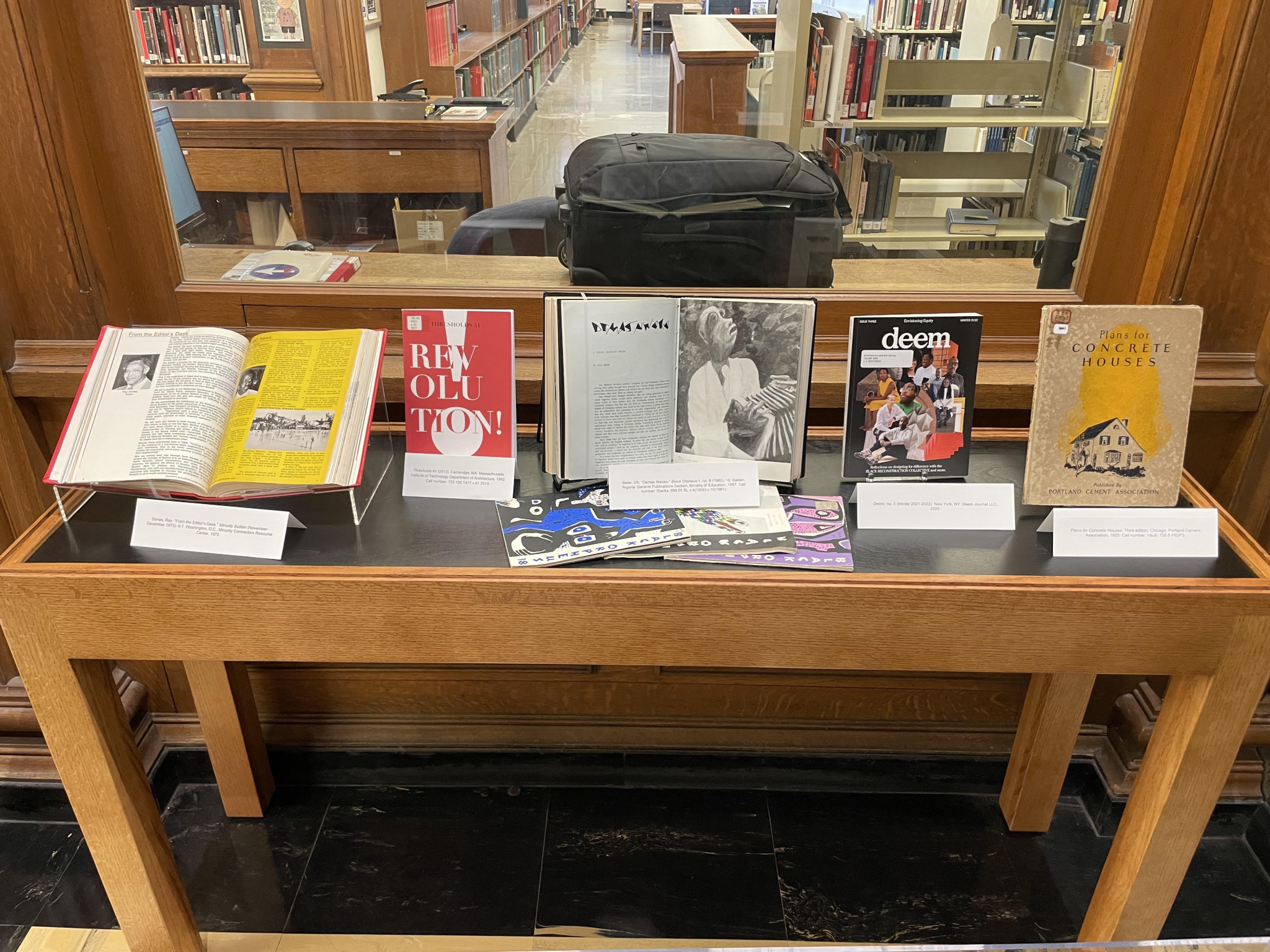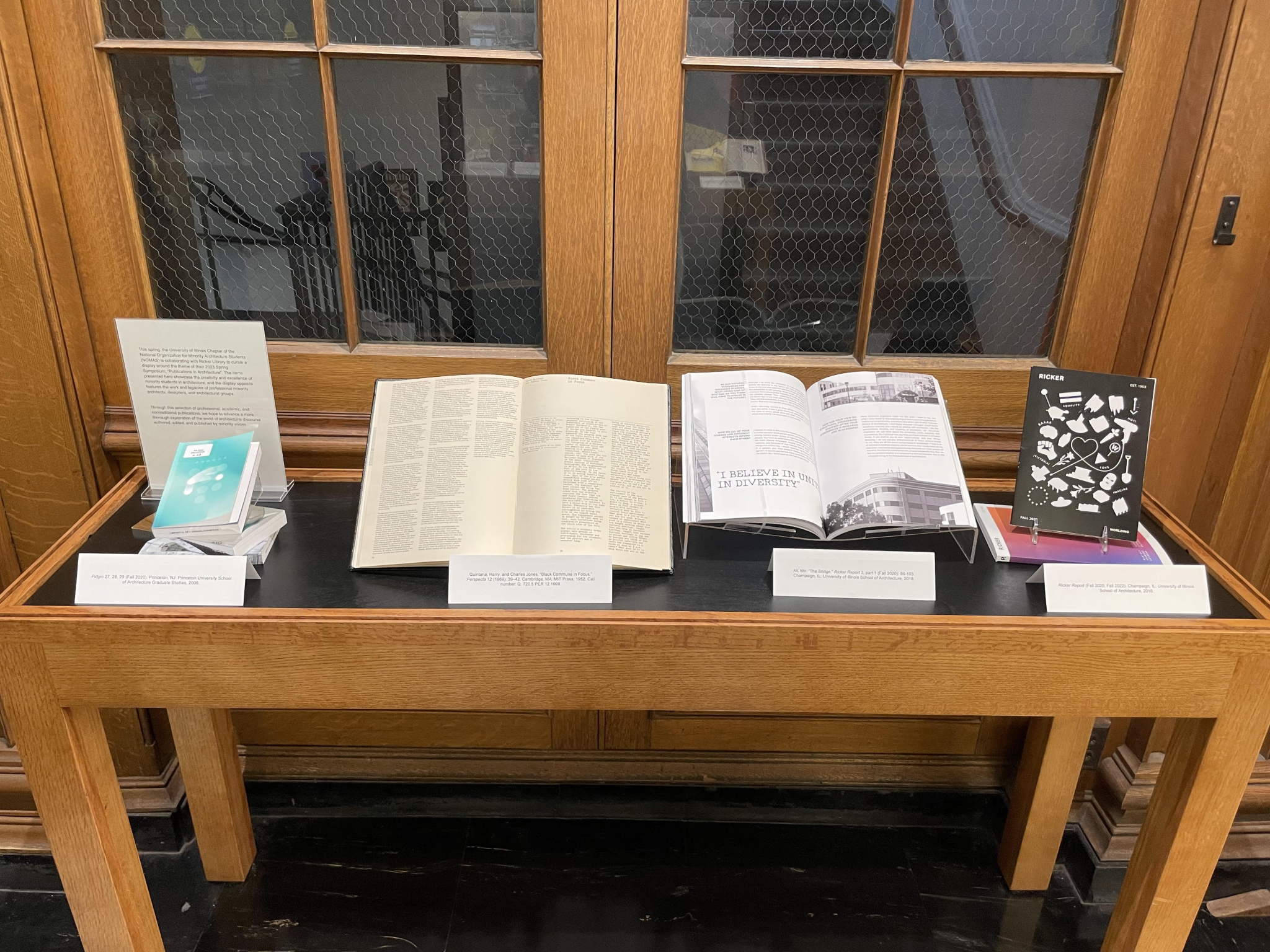“Architectural Publications Run, Edited and Authored by Minorities in the Field”
This spring, the National Organization of Minority Architecture Students of the University of Illinois at Urbana-Champaign Chapter held their annual symposium in collaboration with the Ricker Library of Architecture and Art. This year’s theme was “Publications in Architecture”, and alongside NOMAS student researchers, we curated a display of student and professional architectural publications run by minorities in the field from Ricker’s collections.

In 1969, students at Howard University School of Architecture were growing dissatisfied with their curriculum, which they described as being “written by whites for the planning of white America” (Quintana and Jones, 39). For a project that would serve as the capstone of their degree, students Harry J. Quintana and Charles Jones designed a communal housing network for urban Black populations in Northwest Washington, D.C. Centering the ever-changing size and structure of extended family units, Quintana and Jones designed a complex of living units that would “expand and contract according to the way a family expands and contracts” (Quintana and Jones, 40). The arrangement of units and complexes around shared spaces embraced a communalism that looked inward for its needs, and a strong social fabric of local community centers rendered an institutional police force and motor vehicles unnecessary. Civil-rights activist, author, and organizer Kwame Ture (formerly Stokely Carmichael) accepted the students’ invitation to participate as a guest critic on the architectural jury for his expertise in identifying the needs of an urban community. We included the article written by Quintana and Jones and published in the 1969 issue of Perspecta, the Yale School of Architecture’s student-run journal, in our display exhibition.
The students of Princeton University’s Pidgin and our very own Ricker Report have upheld this legacy in their most recent publications. Pidgin’s 28th issue (Fall 2020) begins with an “Open Letter on Anti-Racism to the Princeton School of Architecture” by Princeton School of Architecture for Black Lives (PSoA4BL). The letter includes excerpts of a statement by Kim Dowdell, President of NOMA 2019-2020, and implores the university to respond to students’ calls for racial justice and commit to a strategic plan for systemic change. The Fall 2022 issue of the Ricker Report takes up everything from antifascist architecture to the Great Lakes Architectural Expedition. Through a lens of worlding, students of the Illinois School of Architecture glimpse into “worlds that could have been and are still yet to be” (Arun et al., 3).
Minority voices in architecture publications are not confined to student work, and we took care to highlight professional publications run and authored by minorities in our display exhibition. Plans for Concrete Houses, issued by the Portland Cement Association of Chicago in 1925, advertises a design by Paul Revere Williams, who became the first African American member of the American Institute of Architects in 1923 and designed more than 2,000 buildings in his lifetime. An article in the eighth issue of the African literary and arts magazine Black Orpheus grants us an early profile of Demas Nwoko in 1960, prior to his career as a prolific architect and designer. In 1965, instructors of architecture at the University of Santiago, Chile collectively resigned from their positions over dissatisfaction with the school and created Arquitectura Urbanismo Construcción y Arte, also known as AUCA, which means “rebel” in the indigenous Mapudungun language. The independent professional magazine would become a powerful voice in Chilean architecture and advocated for social housing and urban improvement until its dissolution in 1986. The November-December 1973 issue of Minority Builder, the official publication for the National Association of Minority Contractors, the National Organization of Minority Architects, and the National Council of Minority Consulting Engineers captures their fight for contracts and employment for disadvantaged areas under Section 3 of the 1968 Housing Act. Contemporary issues of Deem Journal and Thresholds (MIT School of Architecture) counter-balanced these works by celebrating recent innovations by internationally recognized artists, scholars, and practitioners in the field.

The items presented in our final display showcased the creativity and excellence of minority students in architecture and the work and legacies of professional minority architects, designers, and architectural groups. Through our research and selection of professional, academic, and independent publications, we hope to advance a more thorough exploration of the world of architectural discourse authored, edited, and published by marginalized voices. Images of the items featured can be viewed on Ricker Library’s social media.
Bibliography
Arun, Shravan, Fiz Hassan, Gabriela Abril-Reyes, Ayusmita Deka, Sirisha Reddy, Defne Ergun, and Stuti Bhardwaj, eds. “Worlding.” Ricker Report, no. 10 (2022): 3. https://issuu.com/artsatillinois/docs/ricker_report_fall_2022.
Beier, Ulli. “Demas Nwoko.” Black Orpheus 1, no. 8 (1960): 10. Ibadan, Nigeria: General Publications Section, Ministry of Education, 1957.
Dones, Ray. “From the Editor’s Desk.” Minority Builder (November-December 1973): 6-7. Washington, D.C.: Minority Contractors Resource Center, 1972.
Grandoit, Alice, Isabel Flower, and Nu Goteh, eds. “Envisioning Equity.” Deem, no. 3 (2022).
Plans for Concrete Houses. Third edition. Chicago: Portland Cement Association, 1925. Call number:
Princeton School of Architecture for Black Lives. “Open Letter on Anti-Racism to the Princeton School of Architecture.” Pidgin, no. 28 (2020). Princeton, NJ: Princeton University School of Architecture Graduate Studies, 2006.
“Quienes Somos?”. Arquitectura, urbanismo, construcción, arte: AUCA, no. 1 (December 1965). Santiago, Chile: Ediciones AUCA, 1965.
Quintana, Harry, and Charles Jones. “Black Commune in Focus.” Perspecta 12 (1969): 39–42. Cambridge, MA: MIT Press, 1952.
Thresholds 41 (2013). Cambridge, MA: Massachusetts Institute of Technology Department of Architecture, 1992.
Display Works Included
Ali, Mir. “The Bridge.” Ricker Report 3, part 1 (Fall 2020): 86-103. Champaign, IL: University of Illinois School of Architecture, 2018.
Arun, Shravan, Fiz Hassan, Gabriela Abril-Reyes, Ayusmita Deka, Sirisha Reddy, Defne Ergun, and Stuti Bhardwaj, eds. “Worlding.” Ricker Report, no. 10 (2022): 3. https://issuu.com/artsatillinois/docs/ricker_report_fall_2022.
Beier, Ulli. “Demas Nwoko.” Black Orpheus 1, no. 8 (1960): 10. Ibadan, Nigeria: General Publications Section, Ministry of Education, 1957.
Dones, Ray. “From the Editor’s Desk.” Minority Builder (November-December 1973): 6-7. Washington, D.C.: Minority Contractors Resource Center, 1972.
Grandoit, Alice, Isabel Flower, and Nu Goteh, eds. “Envisioning Equity.” Deem, no. 3 (2022).
Pidgin 27, 28, 29 (Fall 2020). Princeton, NJ: Princeton University School of Architecture Graduate Studies, 2006.
Plans for Concrete Houses. Third edition. Chicago: Portland Cement Association, 1925. Call number:
“Quienes Somos?”. Arquitectura, urbanismo, construcción, arte: AUCA, no. 1 (December 1965). Santiago, Chile: Ediciones AUCA, 1965.
Quintana, Harry, and Charles Jones. “Black Commune in Focus.” Perspecta 12 (1969): 39–42. Cambridge, MA: MIT Press, 1952.
Thresholds 41 (2013). Cambridge, MA: Massachusetts Institute of Technology Department of Architecture, 1992.

 Study Architecture
Study Architecture  ProPEL
ProPEL 